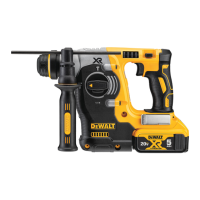7
• The charger is designed to operate on standard 120V
household electrical power. Do not attempt to use it on any
other voltage. This does not apply to the vehicularcharger.
Chargers
Your tool uses a
charger. Be sure to read all safety instructions
before using your charger. Consult the chart at the end of this manual
for compatibility of chargers and batterypacks.
Charging Procedure (Fig. 1)
1. Plug the charger into an appropriate outlet
before inserting the batterypack.
2. Insert the battery pack (G) into the charger,
as shown in Figure 1, making sure the pack
is fully seated in charger. The red (charging)
light will blink continuously, indicating that
the charging process hasstarted.
3. The completion of charge will be indicated
by the red light remaining ON continuously.
The pack is fully charged and may be used
at this time or left in thecharger.
Indicator Light Operation
DCB101, DCB102, DCB103
PACK CHARGING
PACK CHARGED
x
HOT/COLD DELAY
PROBLEM PACK OR CHARGER
FIG. 1
G
overheating. When using more than one extension to make up the
total length, be sure each individual extension contains at least the
minimum wire size. The following table shows the correct size to
use depending on cord length and nameplate ampere rating. If in
doubt, use the next heavier gauge. The lower the gauge number,
the heavier thecord.
Minimum Gauge for Cord Sets
Ampere Rating
Volts Total Length of Cord in Feet (meters)
120V 25 (7.6) 50 (15.2) 100 (30.5) 150 (45.7)
240V 50 (15.2) 100 (30.5) 200 (61.0) 300 (91.4)
More
Than
Not More
Than
AWG
0 6 18 16 16 14
6 10 18 16 14 12
10 12 16 16 14 12
12 16 14 12 Not Recommended
• Do not place any object on top of the charger or place the
charger on a soft surface that might block the ventilation
slots and result in excessive internal heat. Place the charger
in a position away from any heat source. The charger is ventilated
through slots in the top and the bottom of thehousing.
• Do not operate the charger with a damaged cord orplug.
• Do not operate the charger if it has received a sharp blow,
been dropped or otherwise damaged in any way. Take it to an
authorized servicecenter.
• Do not disassemble the charger; take it to an authorized
service center when service or repair is required. Incorrect
reassembly may result in a risk of electric shock, electrocution orfire.
• Disconnect the charger from the outlet before attempting
any cleaning. This will reduce the risk of electric shock.
Removing the battery pack will not reduce thisrisk.
• NEVER attempt to connect 2 chargerstogether.

